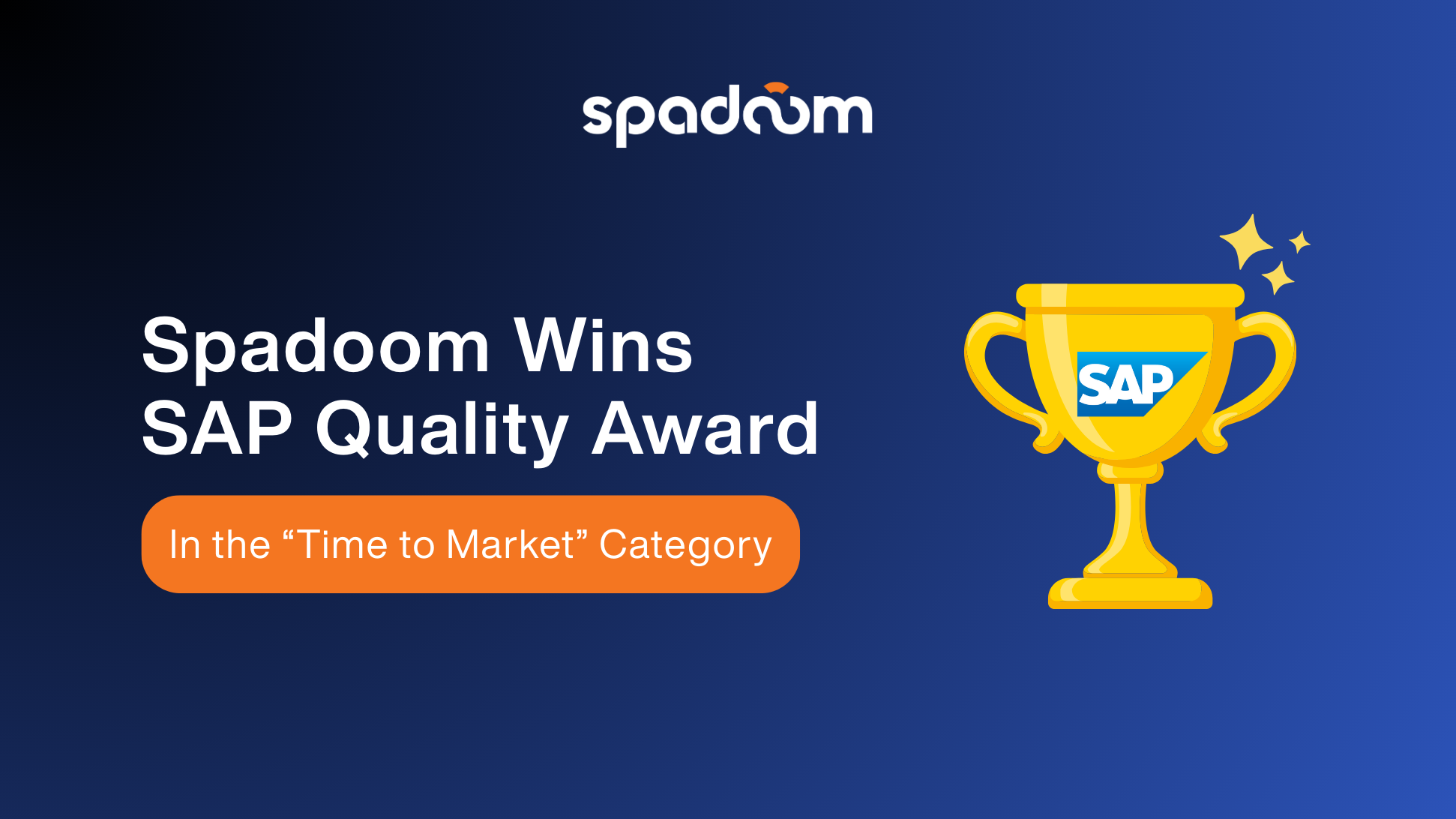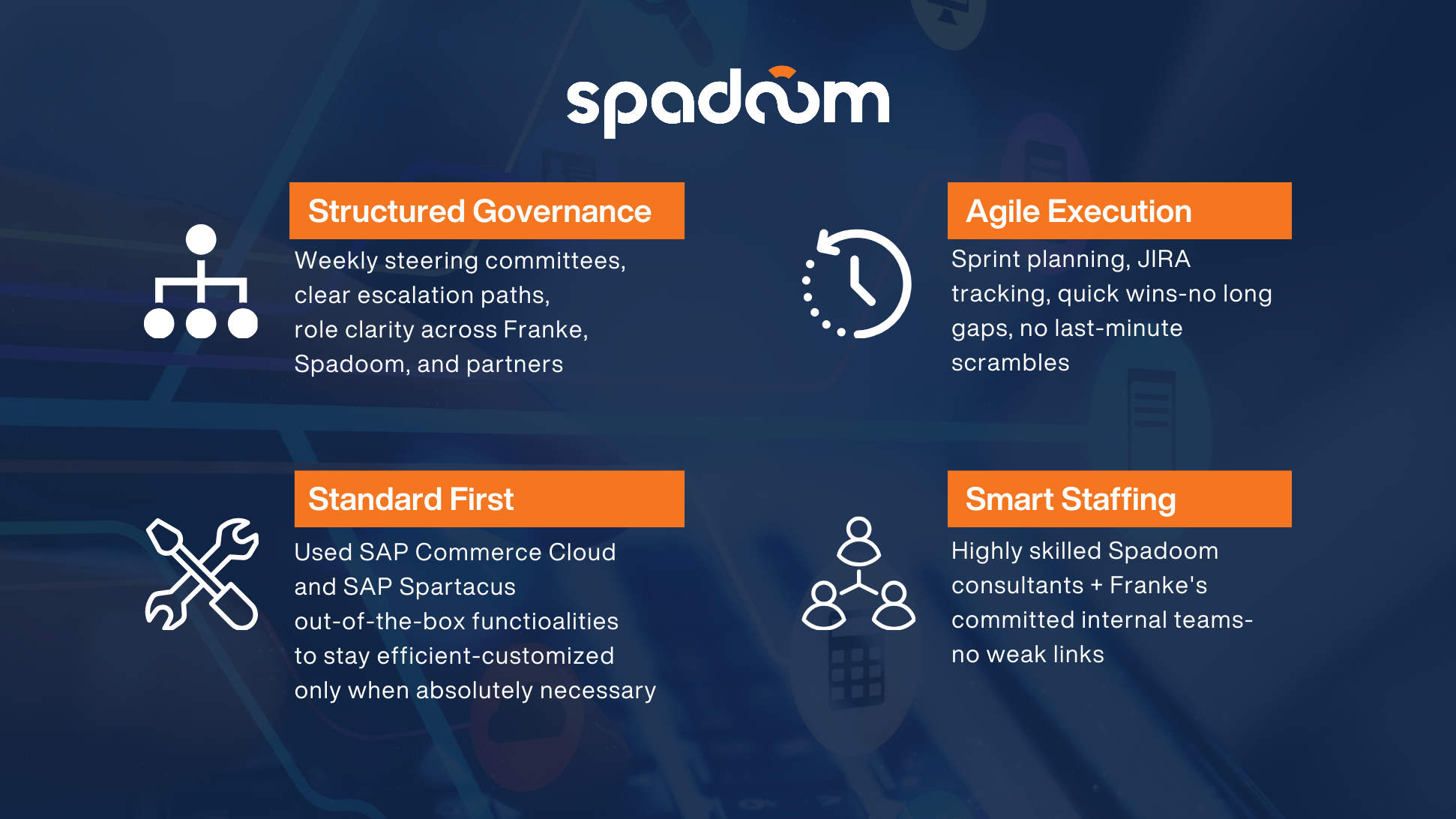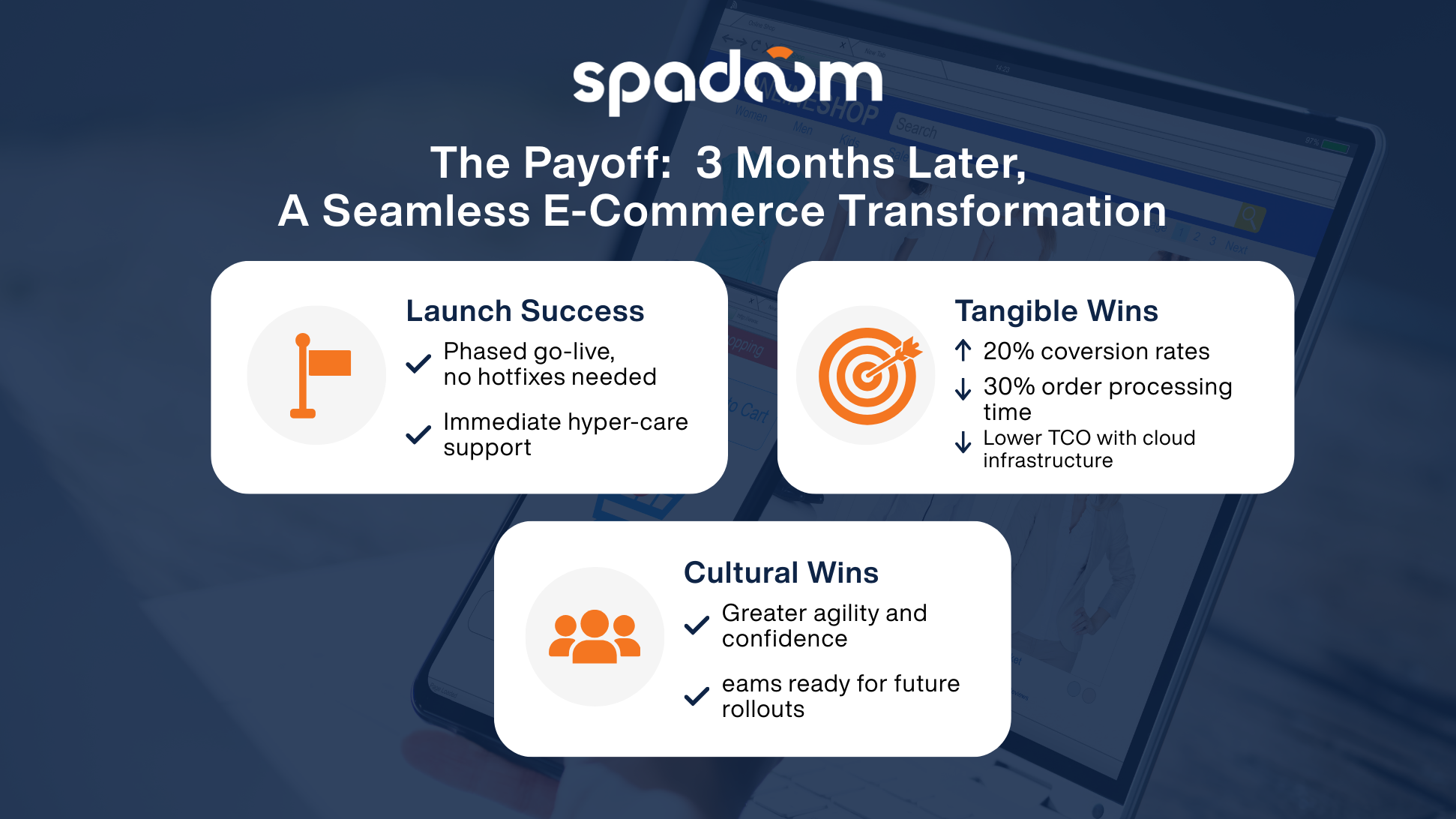When innovation can’t wait, bold moves become the only option. Franke Group, a global leader known for kitchen systems and solutions, envisioned a completely reimagined direct-to-consumer experience. But there was one catch: they needed to launch it across nine countries, and they only had three months to do it.
Modernizing an entire e-commerce system is a big undertaking in itself. Doing it for a multi-country rollout, while balancing regional legal requirements, language barriers, and the ever-rising expectations of today’s digital shoppers? That’s not just a project — it’s a race against time, precision, and complexity.
To take on this challenge, Franke turned to Spadoom, a trusted name for delivering powerful e-commerce solutions. With deep expertise, a clear methodology, and a commitment to fast, scalable delivery, we weren’t just another vendor — we were the partner Franke needed to turn an ambitious vision into reality.
Their success in this project was so outstanding that it earned Spadoom the prestigious SAP Quality Award in the “Time to Market” category.
Let’s take you behind the scenes to see how Spadoom and Franke made the impossible possible — and built a future-ready e-commerce platform in record time.

Nine Markets. Zero Margin for Error. Spadoom Took the Lead
At the heart of Franke’s ambitious plan was a clear mission: to launch a fully modernized, scalable B2C e-commerce experience that could seamlessly operate across France, Germany, Austria, Luxembourg, Italy, Netherlands, Poland, Switzerland, and Liechtenstein.
The goal wasn’t just to build a shop; it was to create a connected digital journey that matched the expectations of today’s global consumers—fast, intuitive, and reliable.
With the clock ticking, there was no room for missteps. Every decision had to push them closer to a seamless customer experience without compromising the structural integrity of the solution.
The Challenges in Building Multi-Country E-Commerce Solutions
Scaling an e-commerce operation across nine different countries came with its share of hurdles. Regional compliance issues surfaced quickly, each country bringing its own set of VAT fields, fiscal codes, and legal peculiarities that had to be flawlessly integrated.
Adding to the complexity was the transition away from outdated legacy systems. Moving years of accumulated processes, data, and workflows into a modern environment required precision and strategic planning.
And, of course, there was the front-end experience to consider. Today’s users expect sleek, responsive design, effortless navigation, and a personalized feel. Delivering a world-class UI/UX wasn’t just a bonus, it was non-negotiable for any E-commerce solutions aiming to truly compete.
The Risks of Falling Short
Failure wasn’t just a theoretical concern, it would have meant delayed market entries, increased operational costs, frustrated customers, and a serious dent in brand credibility.
Every choice made during those three months carried real, tangible consequences, adding even more weight to an already intense journey.
Speed Without Compromise: How Spadoom Structured for Success
Success in a fast-moving project like this one doesn’t happen by chance, it’s engineered through the right choices at every stage. We at Spadoom understood that building a multi-country, scalable platform meant more than just meeting deadlines.
It demanded a strategy built on strong collaboration, smart tools, and an unwavering focus on business goals. Here’s how we made it happen.

Structured Governance
In a project where every week counted, a clear structure wasn’t optional—it was the engine that kept everything moving forward. Franke and Spadoom set up a governance model from day one that provided total clarity on decision-making and communication.
Weekly steering committee meetings brought leadership, project managers, and functional experts together to review progress, tackle roadblocks, and recalibrate priorities when needed.
Clear escalation paths were established, ensuring that no issue sat unresolved for long. Every participant, from IT leads to marketing teams, knew their role and their decision-making authority.
This framework turned a high-pressure timeline into a series of achievable steps, reflecting the kind of disciplined project management approach that’s critical in large-scale digital transformations.
Agile Execution
Rather than trying to blueprint every last detail up front, the project team embraced an agile mindset from the start. Sprint planning cycles gave both Franke and Spadoom a rhythm for development, allowing for constant refinements without losing sight of the bigger picture.
Tools like JIRA provided transparency, helping all stakeholders see exactly where the project stood at any moment.
Instead of long periods of silence followed by rushed deadlines, the teams celebrated quick wins after each sprint, whether it was a compliance feature completed, a new UI module integrated, or a test milestone cleared.
This steady, visible progress kept the energy high and the project on track, demonstrating why agile practices are increasingly seen as success factors SAP projects can’t ignore
Standard First
One of the smartest moves made early on was the commitment to leverage standard, out-of-the-box capabilities wherever possible.
Instead of diving into heavy customizations that would have slowed everything down, the team prioritized SAP Commerce Cloud functionalities and SAP Spartacus components.
By focusing on modular, composable architecture, we were able to roll out key features quickly and adapt them when necessary for local markets. Custom development was reserved only for critical needs, saving both time and future maintenance headaches.
This standard-first approach wasn’t just about meeting deadlines, it was about creating a sustainable platform that could grow with Franke’s vision over the long term.
Smart Staffing
Building a system of this scale in just three months required a dream team; there was no room for slow ramp-ups or mismatched skills.
Franke’s internal teams brought deep knowledge of their processes, customers, and expectations, while Spadoom assembled consultants with specific expertise in SAP Commerce Cloud, agile delivery, and multi-country e-commerce rollouts.
This synergy meant that decisions could be made quickly, technical obstacles were solved efficiently, and everyone stayed focused on delivering value rather than catching up.
It’s a reminder that when it comes to SAP for large enterprises, the people you assign to the project are just as critical as the software stack you choose.
Mid-Project Curveballs: Spadoom Turned Them Into Milestones
Even the most carefully planned projects encounter unexpected twists. What sets great teams apart isn’t avoiding problems; it’s how quickly and smartly they adapt when they arise.
Midway through the journey, we at Spadoom faced new hurdles that could have derailed the timeline. Here’s how we turned potential setbacks into milestones of resilience.
Unexpected Challenges
Three major challenges stood out during implementation. First, integration complexity required careful handling to connect multiple systems, from SAP back-end solutions to external logistics and payment providers.
At the same time, expanding across nine countries surfaced unexpected compliance requirements like tax fields and identification validations.
Lastly, ensuring user adoption within Franke’s internal teams became crucial, as smooth day-to-day operation depended on how quickly teams could adapt to the new workflows and interface.
Together, these hurdles underscored the need for agility, foresight, and constant attention to both technical and user experience factors.
How We Adapted
To manage integration complexity, Spadoom adopted a phased rollout strategy, integrating and rigorously testing each system component before full deployment.
For compliance challenges, early legal consultations were expanded to review and adjust configurations before go-live, ensuring localized needs were properly met.
On the user side, intensive training workshops, walkthroughs, and user feedback sessions were introduced to build confidence and familiarity.
Rather than seeing these obstacles as setbacks, the teams used them to tighten the solution, strengthen user trust, and build resilience into the platform.
The Result
Thanks to these quick adaptations, the project never lost its momentum. Compliance was handled without pushing deadlines, and the user experience grew stronger with every iteration.
This resilience not only preserved the go-live schedule but also elevated the final product, ensuring that Franke’s new platform wasn’t just on time, but truly ready to deliver exceptional value from day one.
In the end, these turning points became proof that agility, collaboration, and a deep commitment to customer success are the real drivers behind lasting digital transformation.
From Tight Deadlines to Tangible Wins: Spadoom Delivered Big
After months of intense work, quick pivots, and careful collaboration, the results spoke for themselves.
Our team at Spadoom didn’t just meet the original project goals, we set new standards for speed, quality, and teamwork. Here’s a look at what we achieved and why it matters moving forward.

Launch Success
The go-live phase, often one of the riskiest moments in any major project, unfolded with remarkable precision. At Spadoom, we opted for a phased approach, releasing the platform in controlled stages to minimize potential disruptions.
This method allowed us to monitor stability at each step, and it paid off: no hotfixes were needed post-launch, a great achievement in large-scale rollouts. Immediate hyper-care support was also in place, giving teams fast troubleshooting backup during the critical early days.
The result was a seamless transition for customers and staff alike, setting a strong first impression and building trust in the platform from day one.
Tangible Wins
Beyond technical success, the business outcomes were clear and immediate. Franke saw a 20% increase in online conversion rates—a direct reflection of the improved shopping experience and performance enhancements.
Order processing times dropped by 30%, thanks to more efficient workflows and backend automation. Perhaps just as importantly, the move to a cloud-based infrastructure significantly lowered the total cost of ownership (TCO), freeing up resources for future innovation.
These numbers weren’t just metrics on a dashboard, they were proof that strategic planning, disciplined execution, and smart technology choices drive real-world business growth.
Cultural Wins
Technology alone doesn’t create transformation; people do. One of the most valuable outcomes of the project was the cultural shift within Franke’s teams. Working in sprints, solving challenges together, and embracing new tools gave teams a newfound sense of agility and confidence.
Instead of viewing future rollouts with apprehension, internal teams are now better equipped, more engaged, and ready to extend the platform’s capabilities across other regions.
In many ways, this cultural evolution may turn out to be the project’s most lasting and most transformative achievement.
Beyond Launch: A Future-Ready Platform Engineered by Spadoom
Completing a successful go-live was only the beginning. The real achievement lies in how the new platform sets the stage for continued innovation and business growth.
Our team at Spadoom worked not just to meet immediate goals but to build an ecosystem ready for tomorrow’s opportunities.
Future-Ready Architecture
The new platform wasn’t designed to stand still—it was engineered to grow. Franke’s e-commerce system now integrates personalized AI-driven product recommendations, helping create a more personalized and intuitive shopping experience for customers.
This move into AI-driven e-commerce opens new opportunities for increased engagement and higher conversions over time. Additionally, the modular storefront architecture means new features, markets, or integrations can be added without disrupting the core system.
Omnichannel capabilities are also being expanded, allowing Franke to deliver a unified experience whether customers are shopping online, interacting through mobile apps, or connecting with service channels. Flexibility and scalability are now built into the DNA of Franke’s digital commerce strategy.
Long-Term Benefits
Looking ahead, the platform’s benefits extend well beyond technical improvements. Lower operating costs, thanks to the cloud-first architecture and reduced manual interventions, free up resources for continuous innovation.
Faster time-to-market gives Franke the agility to launch new initiatives without lengthy development cycles, a critical advantage in today’s dynamic retail landscape.
Perhaps most importantly, enhanced data-driven insights now empower teams to make smarter decisions, whether it’s optimizing product offerings, adjusting marketing strategies, or identifying emerging customer trends. Together, these long-term advantages ensure that the success of this project continues to pay dividends for years to come.
How This Collaboration Led to a SAP Quality Award
True digital transformation isn’t just about speed—it’s about setting a new standard for what’s possible. Spadoom and Franke’s journey proves that with a clear vision, strategic partnership, and a relentless commitment to quality, even the most ambitious goals can become a reality.
This commitment didn’t just lead to a successful launch, it earned the project the prestigious SAP Quality Award in the “Time to Market” category, a recognition of what smart collaboration and expert execution can achieve.
If you’re aiming to transform your business with the same focus and excellence, we at Spadoom bring the same precision and passion to every project we undertake. As a trusted leader in SAP consulting in Switzerland, we help businesses unlock the full power of their SAP solutions and drive meaningful, lasting growth.
Ready to build your success story? Contact us today and let’s make it happen together.



